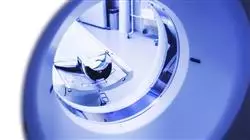University certificate
Scientific endorser

The world's largest faculty of medicine”
Introduction to the Program
Through this Relearning-based Postgraduate diploma, you will develop advanced skills in the field of imaging and provide crucial findings to clarify forensic investigations"

The Fourth Industrial Revolution has brought with it multiple technological advances, which have driven the development of high-resolution medical imaging equipment. Therefore, practitioners in the field of Forensic Radiology operate sophisticated machinery such as Computed Tomography to obtain detailed snapshots of bone and soft tissues. This enables medical professionals to contribute to the identification of unknown deceased individuals by comparing their previous medical records with anthropological and even odontological records. In this sense, specialists provide detailed radiological evidence that can be of great use both during forensic investigations and judicial proceedings.
In this scenario, TECH has developed a complete Postgraduate diploma in Forensic Radiology in Pathologies by Compared Anatomy. Its purpose is to provide a high degree of specialization oriented to the characterization of bone and joint pathologies in radiological photographs. To make this possible, the academic itinerary will carry out an exhaustive analysis of the human skeleton that will allow graduates to identify anomalies such as the presence of relevant foreign objects in cases of traumatic deaths. At the same time, the syllabus will address the most common bone diseases in the forensic context, among which Osteoporosis, Rickets or Cancer stand out. Likewise, the didactic materials will offer the keys to detect signs of child abuse from the data obtained by means of tools such as MRI, X-rays or Axial Tomographies.
It should be noted that the approach of this program reinforces its innovative character. TECH offers a fully online educational environment, tailored to the needs of busy professionals who want to advance their careers. Through the Relearning methodology, based on the repetition of key concepts to fix knowledge and facilitate learning, flexibility is combined with a highly robust pedagogical approach. Additionally, specialists will have access to a library full of cutting-edge multimedia resources.
TECH's online methodology will allow you to choose the time and place to study, without hindering your professional work"
This Postgraduate diploma in Forensic Radiology in Pathologies by Compared Anatomy contains the most complete and up-to-date scientific program on the market. Its most notable features are:
- The development of practical cases presented by experts in Forensic Radiology
- The graphic, schematic and eminently practical contents with which it is conceived gather scientific and practical information on those disciplines that are indispensable for professional practice
- Practical exercises where the self-assessment process can be carried out to improve learning
- Its special emphasis on innovative methodologies
- Theoretical lessons, questions to the expert, debate forums on controversial topics, and individual reflection assignments
- Content that is accessible from any fixed or portable device with an Internet connection
You will incorporate into your daily practice the most innovative Ultrasound techniques to identify pathologies such as bone fractures, joint injuries or soft tissue inflammation"
The program’s teaching staff includes professionals from the field who contribute their work experience to this educational program, as well as renowned specialists from leading societies and prestigious universities.
The multimedia content, developed with the latest educational technology, will provide the professional with situated and contextual learning, i.e., a simulated environment that will provide immersive education programmed to learn in real situations.
This program is designed around Problem-Based Learning, whereby the professional must try to solve the different professional practice situations that arise during the course. For this purpose, students will be assisted by an innovative interactive video system created by renowned and experienced experts.
Do you want to specialize in Forensic Radiology of Pathologies in developing individuals? Achieve it with this syllabus in only 450 hours"

You will have access to a learning system based on repetition, with a progressive and natural teaching throughout the program"
Why study at TECH?
TECH is the world’s largest online university. With an impressive catalog of more than 14,000 university programs available in 11 languages, it is positioned as a leader in employability, with a 99% job placement rate. In addition, it relies on an enormous faculty of more than 6,000 professors of the highest international renown.

Study at the world's largest online university and guarantee your professional success. The future starts at TECH”
The world’s best online university according to FORBES
The prestigious Forbes magazine, specialized in business and finance, has highlighted TECH as “the world's best online university” This is what they have recently stated in an article in their digital edition in which they echo the success story of this institution, “thanks to the academic offer it provides, the selection of its teaching staff, and an innovative learning method aimed at educating the professionals of the future”
A revolutionary study method, a cutting-edge faculty and a practical focus: the key to TECH's success.
The most complete study plans on the university scene
TECH offers the most complete study plans on the university scene, with syllabuses that cover fundamental concepts and, at the same time, the main scientific advances in their specific scientific areas. In addition, these programs are continuously being updated to guarantee students the academic vanguard and the most in-demand professional skills. In this way, the university's qualifications provide its graduates with a significant advantage to propel their careers to success.
TECH offers the most comprehensive and intensive study plans on the current university scene.
A world-class teaching staff
TECH's teaching staff is made up of more than 6,000 professors with the highest international recognition. Professors, researchers and top executives of multinational companies, including Isaiah Covington, performance coach of the Boston Celtics; Magda Romanska, principal investigator at Harvard MetaLAB; Ignacio Wistumba, chairman of the department of translational molecular pathology at MD Anderson Cancer Center; and D.W. Pine, creative director of TIME magazine, among others.
Internationally renowned experts, specialized in different branches of Health, Technology, Communication and Business, form part of the TECH faculty.
A unique learning method
TECH is the first university to use Relearning in all its programs. It is the best online learning methodology, accredited with international teaching quality certifications, provided by prestigious educational agencies. In addition, this disruptive educational model is complemented with the “Case Method”, thereby setting up a unique online teaching strategy. Innovative teaching resources are also implemented, including detailed videos, infographics and interactive summaries.
TECH combines Relearning and the Case Method in all its university programs to guarantee excellent theoretical and practical learning, studying whenever and wherever you want.
The world's largest online university
TECH is the world’s largest online university. We are the largest educational institution, with the best and widest online educational catalog, one hundred percent online and covering the vast majority of areas of knowledge. We offer a large selection of our own degrees and accredited online undergraduate and postgraduate degrees. In total, more than 14,000 university degrees, in eleven different languages, make us the largest educational largest in the world.
TECH has the world's most extensive catalog of academic and official programs, available in more than 11 languages.
Google Premier Partner
The American technology giant has awarded TECH the Google Google Premier Partner badge. This award, which is only available to 3% of the world's companies, highlights the efficient, flexible and tailored experience that this university provides to students. The recognition as a Google Premier Partner not only accredits the maximum rigor, performance and investment in TECH's digital infrastructures, but also places this university as one of the world's leading technology companies.
Google has positioned TECH in the top 3% of the world's most important technology companies by awarding it its Google Premier Partner badge.
The official online university of the NBA
TECH is the official online university of the NBA. Thanks to our agreement with the biggest league in basketball, we offer our students exclusive university programs, as well as a wide variety of educational resources focused on the business of the league and other areas of the sports industry. Each program is made up of a uniquely designed syllabus and features exceptional guest hosts: professionals with a distinguished sports background who will offer their expertise on the most relevant topics.
TECH has been selected by the NBA, the world's top basketball league, as its official online university.
The top-rated university by its students
Students have positioned TECH as the world's top-rated university on the main review websites, with a highest rating of 4.9 out of 5, obtained from more than 1,000 reviews. These results consolidate TECH as the benchmark university institution at an international level, reflecting the excellence and positive impact of its educational model.” reflecting the excellence and positive impact of its educational model.”
TECH is the world’s top-rated university by its students.
Leaders in employability
TECH has managed to become the leading university in employability. 99% of its students obtain jobs in the academic field they have studied, within one year of completing any of the university's programs. A similar number achieve immediate career enhancement. All this thanks to a study methodology that bases its effectiveness on the acquisition of practical skills, which are absolutely necessary for professional development.
99% of TECH graduates find a job within a year of completing their studies.
Postgraduate Diploma in Forensic Radiology in Pathologies by Compared Anatomy
Forensic radiology plays a key role in the identification of bone pathologies in medico-legal investigations, and comparative anatomy offers a unique perspective by comparing human bone structures with those of other species. Are you passionate about this innovative field? This Postgraduate Diploma created by TECH Global University provides you with the perfect opportunity to immerse yourself in this exciting field of study. Through our online program, you will explore a wide range of pathologies, from fractures and tumors to degenerative diseases, using advanced imaging tools. You will also learn to interpret and analyze radiological images to identify bone pathologies and anomalies using anatomical comparison techniques between different species. As a result, you will become an expert in the identification of bone pathologies by means of comparative anatomy.
Get qualified with a Postgraduate Diploma in Forensic Radiology in Pathologies by Comparative Anatomy
The teaching team is composed of experts in forensic radiology, comparative anatomy and forensic medicine, who will guide you throughout your education and provide you with a unique perspective based on their practical experience in the field. In addition to the technical aspect, our program also focuses on developing communication and teamwork skills, as interdisciplinary collaboration is essential in the field of forensic radiology. You will learn to communicate your findings clearly and concisely in both written reports and oral presentations. Upon successful completion of the program, you will be prepared for key roles in the field of forensic radiology and medico-legal investigation, including forensic expert witness, forensic radiologist and more. Our program will provide you with a valuable, internationally recognized credential that will open doors in the exciting world of forensic science. Enroll now and take the first step toward an exciting future in forensic radiology!







